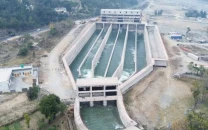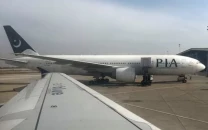Butchers increase prices, ignore official rates
They said that they had raised prices because of a decline in supply owing to the floods.

These shopkeepers are selling mutton at Rs400 to Rs550 per kg and beef at Rs200 to Rs300 per kg. The city district government of Lahore (CDGL) has set the price of mutton at Rs350 per kg and that of beef at Rs175 per kg in the open market, and at Rs300 per kg and at Rs150 per kg, respectively, in its Ramazan Bazaars.
Pervaiz alias Paija, a butcher at Shadman main market, told The Express Tribune that the supply of meat had fallen sharply due to the loss of millions of animals in the floods. “When supply falls and demand increases, prices are bound to rise,” he said.
Muhammad Ramazan, the district officer (Livestock), however, rejected the argument that animal supply had fallen owing to the floods. He said that the city’s two main markets for cattle at Khamboo and Shahpur Kanjaran were still packed with animals. “They have sufficient supply to cater to the city’s demand,” he said.
Pervaiz also raised objections to the CDGL rate list, saying it was not based on ground realities as it was prepared without consulting the butchers.
Lala Ashraf, a butcher who owns a meat shop in Model Town, said that the CDGL should consult all stakeholders, including butchers, when regulating prices.
“They did not bother listening to our concerns and came up with the rate list on their own,” he said.
A CDGL official, speaking on condition of anonymity, said that the district coordinator officer (DCO), Sajjad Ahmed Bhutta, enjoyed discretionary powers to set prices of essential items. He said that the DCO did not call any meeting to listen to different points of opinion before fixing the rates of mutton and beef.
Officials in the Livestock and Dairy Development Department cited three factors for the sharp rise in meat prices since 2009. These included interruption in the movement of livestock due to poor security situation, smuggling across the Afghan border, and increased cost of transportation following the rise in world oil prices.
About the fall in supply owing to the floods, they said, “It will be some time before the loss of livestock in the floods affects supply to the city. For now, the markets are loaded with animals,” they said.
Another condition responsible for the recent rise in meat prices, the officials said, was the sudden surge in the prices of fodder. The production of animal fodder fell owing to a drought this December and January, they said.
A Livestock Department official said that prices had been rising since the government allowed meat export in 2000.
He said that permission to export was tied to the condition that the exporters would export only 40 per cent of their livestock, leaving 60 per cent for the local market. “Not a single exporter has abided by these conditions,” he said.
According to the Federal Bureau of Statistics, the value of meat export expanded by almost 40 per cent in just a year’s time –from $52 million (19,175 tons) in 2008-09 to $72 million (27,347 tons) in 2009-10.
Haji Muhammad Fiaz, an exporter, said that at present the total population of buffalo stood at 48.1 million, and of goat and sheep at 77.4 million. These figures, he said, were rising at a rate of 25 per cent per annum.
He added that meat production for beef stood at 1,060 million tons and for mutton at 702 million tons.
He said that in order to stabilise prices, it was essential to get rid of the middlemen. They purchase a large quantity of cattle from wholesale traders and later sell it to the butchers on credit at inflated prices, he said.
Published in The Express Tribune, August 21st, 2010.



















COMMENTS
Comments are moderated and generally will be posted if they are on-topic and not abusive.
For more information, please see our Comments FAQ